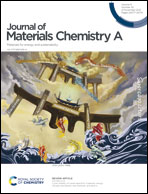A composite surface configuration towards improving cycling stability of Li-rich layered oxide materials†
Abstract
Li-rich layered oxides are promising positive electrode candidates for next-generation high-energy Li-ion batteries. However, they suffer from a severe gas release issue and side reaction-induced surface degradation resulting in significant capacity fade and voltage decay. Herein, this work proposes a composite surface configuration by coordinating the three different structures from Nb/Al surface doping, surface oxygen vacancies and Al2O3 layer via solution coating. A comprehensive characterization provided persuasive evidence that the composite surface configuration not only mitigates oxygen release but also regulates Li+ ion extraction/insertion during cycling. Due to the reduced side reaction and promoted surface stability, a decent specific discharge capacity of about 270 mA h g−1 at 0.1C between 2.0 and 4.6 V vs. Li+/Li was achieved with 57.0% capacity preservation after 1000 cycles at 1C. Most importantly, a 20 A h pouch cell fabricated with this surface-modified positive electrode and an SGC/Gr-negative electrode delivered 345 W h kg−1 in specific energy and retained 77.9% of it at 0.2C after 340 cycles.



 Please wait while we load your content...
Please wait while we load your content...